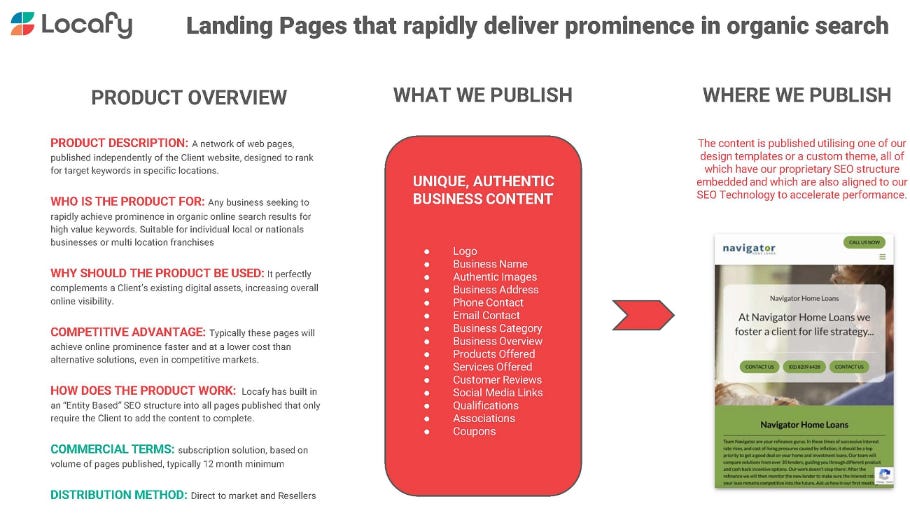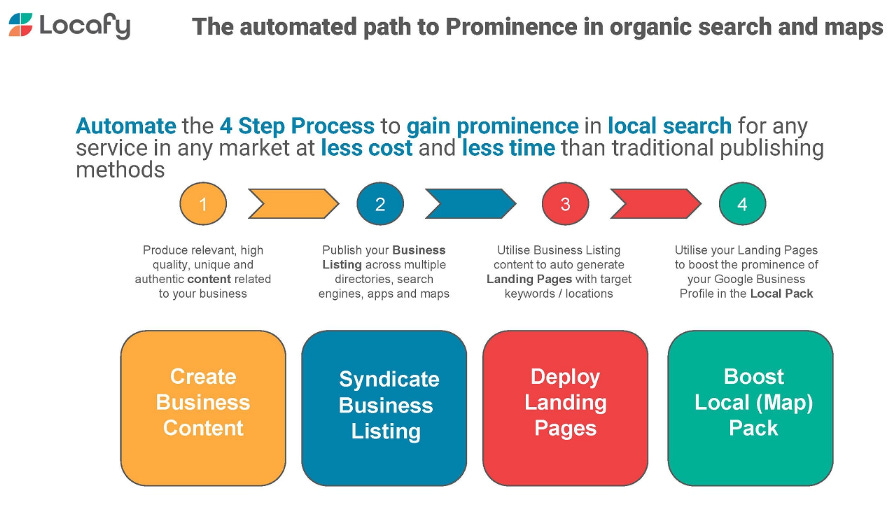Introduction
Locafy (LCFY) is a SaaS-based SEO provider. Its entity-based SEO technology automatically creates SEO-optimized content like business listings, landing pages and articles optimized around specific entities (businesses, products, services, or locations, see here for an explanation of Entities).
Locafy also owns a portfolio of online directories including Hotfrog, AussieWeb, PinkPages, and SuperPages, boasting over 60 million business listings and a substantial email database.
The company is in the final stages of revamping its business model which is setting it up to be able to service much bigger customers in a more automated way, which is making the shares very interesting despite weak financial performance in 2024 so far.
In this article, we describe these fundamental changes and the advantages these are supposed to deliver and the article serves as a reference article (‘primer’), a follow-up article will discuss the latest developments.
Business model
The company offers a highly automated platform that produces different products to increase Google rankings, which are based on:
Relevance; Does the content in your website and GBP (Google Business Profile) match the search query?
Distance; Does your business provide the service in the immediate proximity of the search query?
Prominence; How well-known is your business based on site traffic, brand authority (according to Google) reviews, and the overall consistency of your online presence?
99% of consumers do not go past page 1 of search results.
Locafy’s platform automatically generates multiple products (listings, landing pages, local pack, and articles) from content that customers enter into the platform (articles have to be checked for content and SEO properties although the site structure mostly determines the latter).
It all starts with content
Amplifying the content
Syndication increases Google rankings further
The company has several business listings assets, taking listings from citation management companies (20+ partners) to get their clients onto Locafy’s listings.
Locafy’s business listing sites earn through ad money, listing fees from citation management companies (the publishing partners) and serve to provide directories to give articles more relevance (see below).
Automatically generate SEO rich landing pages
Locafy can automatically generate up to 200 optimized landing pages for each client. This automation allows businesses to quickly establish a significant online presence without extensive manual effort, which is particularly beneficial for local SEO.
The Google ranking derives from the site structure, much less from the content. SEO is for ranking, content is for conversion.
They are targeting large customers like industry groups, which can buy thousands of landing pages for their members at once.
Boosting local prominence
Powerful especially in combination with the landing pages gaining prominence for multiple keywords in your local area. And it’s working:
Automatically generate articles
Based on the same core technology that is behind the creation of landing pages.
This is a recent addition, the result of Google algorithm changes that penalized advertorial content on domains of big publishers.
The company already has won a big contract worth up to $6.5M from one of America’s biggest publishers and a few POCs (Proof of Concept) going on.
The company can publish hundreds of articles in a single business category giving these articles instant contextual relevance.
The company will white-label this solution for customers, using that in a subdomain (to avoid the Google penalties for use in the main domain) in 2025.
The company has been experimenting with a GenAI solution that automatically converts business information (entered into the platform) into high-ranking articles.
Build/buy more publishing assets
Building sites for the finance industry, real estate, and health are already planned for the big media partner the company won.
Doing this on its own assets gives the company so much more control, not only to optimize SEO (which is mostly a function of the site construction) but also to get customers to pay and stop them from doing things that detract from the SEO efficiency.
It involves creating a directory structure and an article structure. They benefit from the 60M+ listings they already have, which provides great context value so they can build any directory for almost any category from existing resources and have immediate relevance. The directory is the foundation for web
Then overlay that with the article application which enables anyone in the industry to create and publish an article on that site.
These sites are built for the big media client, but once the sites are built for specific categories they can be leveraged for other customers publishing articles in the same categories. Once the domain authority is there, POC is just 30 days for additional articles because the heavy SEO lifting has already been done (remember, that’s mostly a function of the site).
Locafy will opportunistically buy websites with great content but low SEO and quickly get the latter up to speed and add content. The articles have more value as they generate more traffic and generate more ad revenue.
Reporting
All these products are subject to very detailed reporting (pulled from Google) so the customer can see the improvements.
Competitive advantage
The platform involves a great deal of automation, making it very scalable and once the infrastructure is built, it can be leveraged over many customers, enabling the company to go after big customers such as:
Large media companies.
Industry groups.
Large marketing agencies.
Not to mention the 20+ listing partners that are already plugged into the platform through APIs.
All of these have thousands of customers and could buy thousands of landing pages or articles for their customers in one go.
The company has a first-mover advantage in offering solutions for advertorials (third-party paid articles that generated significant income for big publishers) after Google started to punish these advertorials on the main directory of publishers early in 2024.
This third-party paid advertorial market is a huge market given the several dozen-sized specialized sales force that its big media client employs to drum up this business.
Locafy is solidifying that first-mover advantage in advertorials through building SEO-optimized websites in specific categories which domain authority rankings benefit greatly from the directories they own, increasing the relevance of published articles.
They are even experimenting with an AI-driven app that automatically creates articles from the content that customers load on the platform.
These owned sites offer benefits as they are under full control of the company so clients can’t mess with the SEO optimization and can be shut off if they don’t pay.
Locafy can also offer it as a white-label solution for large customers.
The combined assets and business model enables scale and a high degree of automation and the infrastructure can be leveraged over multiple clients.














